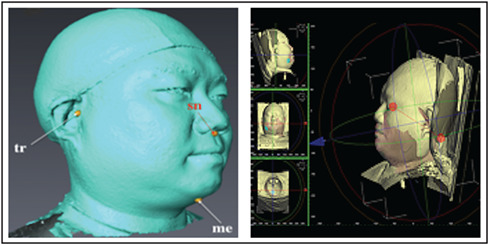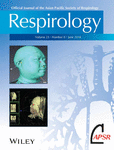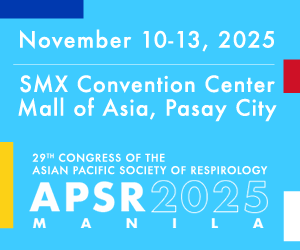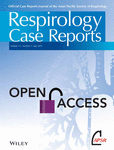Journal list menu
Export Citations
Download PDFs
ISSUE INFORMATION
EDITORIALS
Vitamin D deficiency can impair respiratory health
- Pages: 554-555
- First Published: 12 March 2018
Pulmonary hypertension in combined pulmonary fibrosis and emphysema: A tale of two cities
- Pages: 556-557
- First Published: 11 March 2018
Picking the winners: Outcome prediction in pleural disease
- Pages: 558-559
- First Published: 07 February 2018
Three-dimensional facial phenotyping in obstructive sleep apnoea
- Pages: 560-561
- First Published: 06 March 2018
COMMENTARIES
Difficulties of predicting the timing, size and severity of influenza seasons
- Pages: 562-563
- First Published: 11 April 2018
An alternative approach to the current diagnostic guidelines for fibrotic interstitial lung disease
- Pages: 564-566
- First Published: 23 March 2018
INVITED REVIEW SERIES
Tuberculosis Updates 2018
Epidemiological, clinical and mechanistic perspectives of tuberculosis in older people
- Pages: 567-575
- First Published: 01 April 2018
ORIGINAL ARTICLES
Asthma and Allergy
Vitamin D and respiratory health in the Busselton Healthy Ageing Study
- Pages: 576-582
- First Published: 24 January 2018

Vitamin D in relation to respiratory disease was examined by cross-sectional analysis of a large community-based sample. Low levels of serum 25-hydroxyvitamin D were independently associated with asthma, bronchitis, wheeze and chest tightness after three levels of adjustment for potential confounders. Higher vitamin D levels were associated with higher levels of lung function.
See related Editorial
COPD
Patterns of use of long-acting bronchodilators in patients with COPD: A nationwide follow-up study of new users in New Zealand
- Pages: 583-592
- First Published: 18 December 2017
In this nationwide follow-up study of patients initiating long-acting beta2-agonist (LABA) and/or longacting muscarinic antagonist therapy (LAMA) for chronic obstructive pulmonary disease, the most common first regimen was a LABA with an inhaled corticosteroid (ICS). ICS use was inconsistent with guidelines. There were complex therapy patterns, including periods of non-use.
Interstitial Lung Disease
Likelihood of pulmonary hypertension in patients with idiopathic pulmonary fibrosis and emphysema
- Pages: 593-599
- First Published: 13 December 2017

In combined pulmonary fibrosis and emphysema (CPFE), the likelihood of having pulmonary hypertension (PHT) is explained by the summed baseline computed tomography (CT) extents of interstitial lung disease and emphysema. There is no synergistic effect in CPFE increasing the likelihood of PHT. CPFE is therefore not associated with a malignant microvascular phenotype.
See related Editorial
Overlap of interstitial pneumonia with autoimmune features with undifferentiated connective tissue disease and contribution of UIP to mortality
- Pages: 600-605
- First Published: 10 January 2018
Interstitial pneumonia with autoimmune feature (IPAF) criteria were recently established to clarify research definitions for interstitial lung disease (ILD) patients with features of autoimmune disease. Our study found these criteria encompassed the majority of patients previously diagnosed as UCTD-ILD and did not exclude radiological or histological usual interstitial pneumonia (UIP) (IPAF with UIP features), whose survival was indistinguishable from idiopathic pulmonary fibrosis (IPF).
Co-morbidity and mortality among patients with interstitial lung diseases: A population-based study
- Pages: 606-612
- First Published: 18 December 2017
This study reports the findings in a large population-based interstitial lung disease (ILD) cohort identified from national medical registries. Mortality was increased among patients with ILD at all levels of co-morbidities, but the difference in mortality between ILD patients and matched controls decreases with increasing burden of co-morbidities.
Pleural Disease
Success rate of medical thoracoscopy and talc pleurodesis in malignant pleurisy: A single-centre experience
- Pages: 613-617
- First Published: 10 January 2018
Identifying factors determining the success of talc pleurodesis in malignant pleurisy could guide clinical decision-making. This observational survey shows that a delay in referral of symptomatic patients for pleurodesis might compromise its success. Ultrasonic assessment of potential lung expansion can help to identify trapped lung.
See related Editorial
Sleep and Ventilation
Three-dimensional photography for the evaluation of facial profiles in obstructive sleep apnoea
- Pages: 618-625
- First Published: 20 February 2018

Craniofacial structure is an important determinant of obstructive sleep apnoea (OSA) syndrome risk. Rapid quantitative analysis of facial surface morphology is needed for large population-based studies. Radiation-free three-dimensional stereo-photogrammetry provides accurate craniofacial measurements in patients with OSA which are highly concordant with those obtained by computed tomography.
See related Editorial
LETTER FROM ASIA-PACIFIC REGION
YEAR IN REVIEW
Year in review 2017: Interventional pulmonology, lung cancer, pleural disease and respiratory infections
- Pages: 628-635
- First Published: 11 April 2018
CORRESPONDENCE
M/XDR-TB treatment perspective: How to avoid mountains of pills via digital technologies
- Pages: 636-637
- First Published: 27 April 2018
See Reply
M/XDR-TB treatment perspective: How to avoid mountains of pills via digital technologies – Reply
- Page: 637
- First Published: 27 April 2018
See Letter










-1652674259.png)

